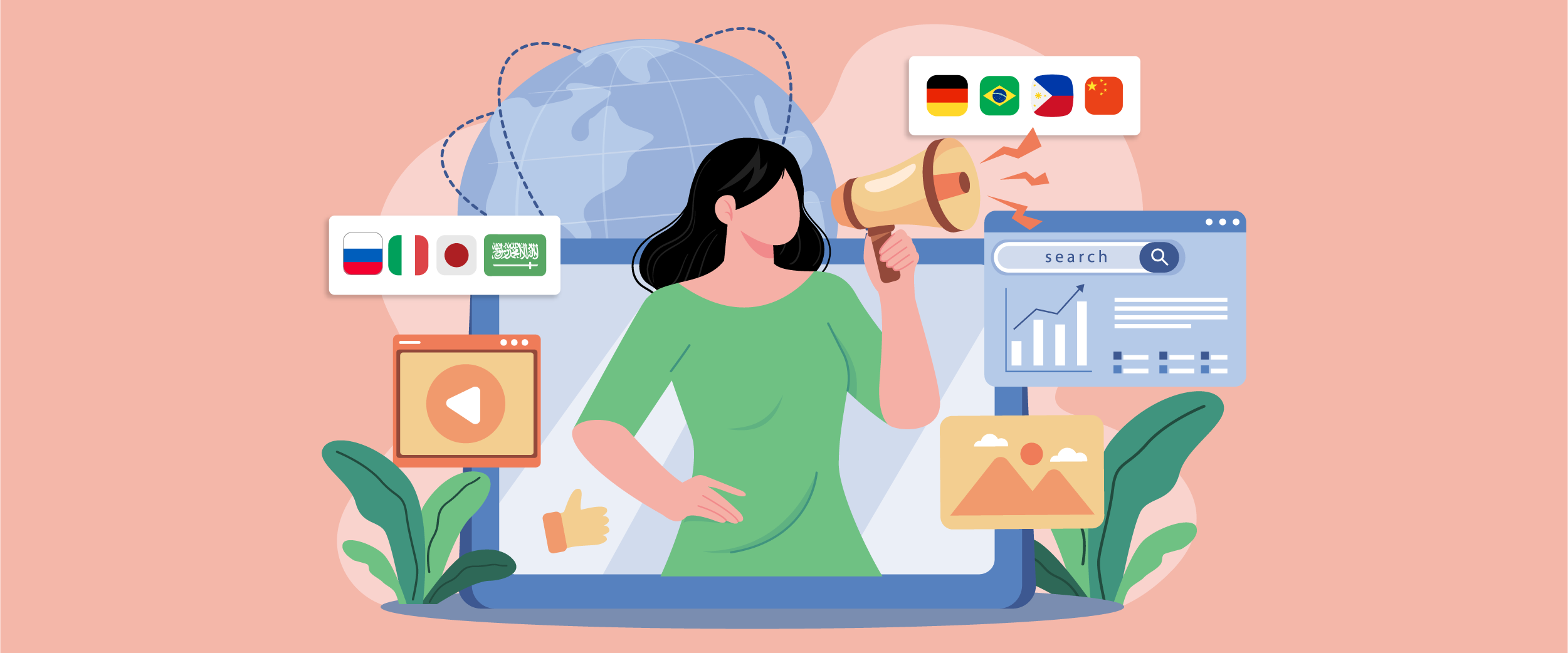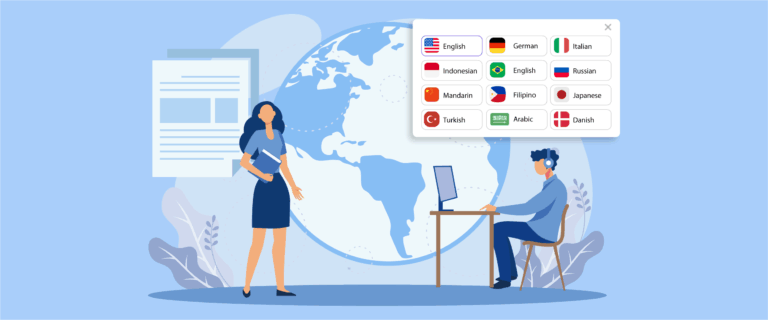International affiliate marketing translation helps marketers reach audiences beyond their home market. When promoting products or services globally, language becomes more than just a medium, it’s how you earn trust and drive conversions. A message that feels natural in someone’s native language often performs better than sounds translated, making localization a key part of any successful affiliate strategy.
Affiliates need more than word-for-word translation to grow revenue across languages. By localizing content, adapting cultural nuances, and using data to guide decisions, affiliate marketers can connect more authentically with users and maximize their international performance.
Why translation matters in international affiliate marketing?

Expanding affiliate marketing globally it’s about communicating in a way that feels native to each audience. Translation is vital in building credibility, improving engagement, and increasing market conversion rates. Here’s why translation matters:
- Builds trust with local audiences – People are likelier to trust and purchase from brands that speak their language naturally. Accurate translation shows respect for cultural identity and helps establish credibility in new markets.
- Improves conversion rates – When users clearly understand a message, they’re more confident in taking action, whether signing up, clicking a link, or making a purchase. Localized content directly impacts conversion performance.
- Enhances user experience – A seamless browsing experience in the user’s native language reduces confusion and bounce rates. Translation ensures users can comfortably navigate offers, terms, and calls to action.
- Expands reach into untapped markets – Translating content opens doors to regions with lower competition but high potential for affiliate sales. This helps marketers tap into new audiences while maintaining strong ROI.
- Supports brand consistency across regions – Consistent translation and tone across languages strengthen global brand presence, ensuring that users everywhere perceive the same level of professionalism and trustworthiness.
Building a multilingual affiliate strategy

Creating a multilingual affiliate strategy involves understanding where and how your message will have the biggest impact. By combining data, cultural insight, and smart localization, affiliate marketers can design campaigns that speak directly to each audience and drive better results worldwide.
Finding key markets
Before starting translation, it’s important to identify which language markets are worth targeting. Not every region brings the same return, so analyzing web traffic, search volume, and audience purchasing behavior helps determine where the highest potential lies. For example, a website that already attracts visitors from Latin America but only offers English content might see a major boost by adding Spanish and Portuguese versions.
Another factor is competition. Some markets, such as English or German, are already saturated with affiliate content. Targeting emerging markets, like Thai, Turkish, or Arabic, can offer less competition and higher conversion potential. The key is to focus on where your niche has demand but few quality local resources.
Localizing pages & CTAs

Localization goes beyond text translation; it’s about adjusting the user experience. This includes adapting calls-to-action (CTAs), currency, units of measurement, and even color preferences that align with local expectations. For instance, a “Buy Now” button that works well in the U.S. might perform better as “Order Today” in Japan, where softer phrasing is preferred.
The layout and visual hierarchy of your landing pages may also need adjustment. Some languages, like Arabic or Hebrew, read from right to left, which affects design flow. Ensuring that the localized page feels natural and easy to navigate for the target audience can significantly improve engagement and conversion rates.
Cultural adaptation
Cultural adaptation ensures your message feels authentic and respectful in every region. This involves understanding local values, humor, and communication styles so your content resonates emotionally. For example, a campaign that uses bold humor in English might need to be rephrased for Japanese audiences, where subtlety and politeness are more effective.
Even visuals and product examples should be culturally relevant. A fitness affiliate promoting home workout gear might use models wearing modest clothing for Middle Eastern audiences, while using casual attire for Western markets. These small but meaningful adjustments help your campaign connect genuinely with local users.
Brand consistency

While tailoring content for each market, maintaining a consistent brand identity is essential. Your tone, values, and overall message should feel familiar no matter the language. This consistency builds trust and helps audiences recognize your brand globally, even when the content is localized.
To achieve this, create clear brand guidelines and a multilingual style guide. Define how slogans, product names, and key phrases should be translated or adapted. For instance, if your brand tagline is “Empowering Everyday Choices,” ensure the translated version in each language reflects the same empowering spirit, not just the literal meaning. This keeps your global message strong while allowing local flexibility.
Translation techniques for affiliate success

Successful affiliate marketing across languages depends on how well the message is translated and localized. The goal isn’t just to change words from one language to another, but to communicate meaning, tone, and intent that resonate with local audiences. Affiliate marketers can use translation techniques to maintain message accuracy while improving clarity and emotional impact.
Translating with context
Translation without context often leads to misunderstandings or awkward phrasing. Affiliate content, especially promotional or product descriptions, must be translated with full awareness of its purpose and target audience. For instance, a phrase like “limited-time deal” might need to be rephrased depending on how urgency is expressed in another culture.
Context also includes understanding where the translation appears whether in an email subject line, a banner ad, or a landing page. Each format demands a different tone and word choice. Translators who understand this context can adapt messages more effectively, keeping clarity and persuasion intact.
Best Practice: Always provide translators with full context, including screenshots, design layouts, or campaign goals so that they can adjust tone and style accordingly. This prevents literal translations and helps ensure that the final message feels natural in every market.
Terminology control
Consistency is key when managing multilingual affiliate campaigns. Terminology control ensures that all materials uniformly translate brand names, product terms, and key phrases. For example, if you promote a “Premium Plus Plan,” it should not appear as “Advanced Plan” or “Elite Package” in another language, as this could confuse users or weaken brand identity.
Controlled terminology also helps maintain professional credibility. Users who see consistent terms across ads, landing pages, and partner sites perceive the brand as reliable and organized. It creates a seamless experience for building trust and recognition in competitive markets.
Best Practice: Develop a multilingual glossary that includes approved translations for key terms, taglines, and product names. Keep it updated and share it with everyone involved in your affiliate localization process to ensure brand consistency.
Using translation memory systems

A Translation Memory (TM) system stores previously translated sentences or phrases to be reused in future projects. This saves time, improves consistency, and reduces costs for ongoing affiliate campaigns. For example, if “Sign up for free” appears in multiple landing pages, the TM can automatically suggest the same approved translation each time.
TM systems are especially useful for large-scale affiliate operations that produce recurring promotional content, newsletters, or seasonal campaigns. It allows teams to maintain linguistic accuracy while speeding up delivery across multiple languages.
Best Practice: Combine your TM with a Translation Management System (TMS) to automate workflows and centralize updates. This ensures that every translator works from the same database, minimizing errors and keeping brand language unified across all markets.
Local tone & style
Tone and style define how your brand “sounds” to audiences, and they can vary dramatically between cultures. In affiliate marketing, a casual, enthusiastic tone might work well in English-speaking markets but could feel too direct in Japanese or German. Adapting tone ensures your message feels natural, persuasive, and culturally appropriate.
Style also involves sentence structure and word choice. Some languages prefer concise expressions, while others value formality and detail. Adjusting your writing style helps make your offer more appealing and relatable to each target market.
Best Practice: Create tone and style guidelines for each language you target. Include examples of do’s and don’ts, preferred expressions, and tone levels. This helps translators and content editors maintain a consistent voice that fits your brand and your audience’s expectations.
SEO and market penetration across languages

Reaching a global audience through affiliate marketing requires more than translation and strong multilingual SEO. Search engines rank content differently across regions, so understanding how users search in their language is essential. Affiliates can improve visibility and conversions across markets by optimizing for local keywords, improving on-page SEO, and structuring websites properly.
Keyword localization
Keyword localization involves adapting search terms to match how users in each market actually look for products or information. Directly translating English keywords rarely works because search intent and phrasing differ by language. For instance, English users may search “best VPN deals,” while in Spanish, the equivalent high-traffic term might be “ofertas VPN seguras.”
Effective keyword localization starts with in-market research using tools like Google Keyword Planner, Ahrefs, or Semrush with regional filters. This ensures you’re targeting the right phrases for each audience segment.
Tip: Don’t just translate your keywords, localize them. Analyze search intent, slang, and variations in spelling or phrasing to match how your target audience truly searches online.
On-page optimization

Once you’ve localized your keywords, they must be integrated naturally into on-page elements like titles, headings, meta descriptions, and image alt text. Each language should have its optimized version, not a copy of the English layout. For example, if your English title tag reads “Top 10 Affiliate Tools for Beginners”, the French version might be “Les 10 meilleurs outils d’affiliation pour débutants.”
Also, ensure that internal links, URLs, and navigation are localized. This improves SEO and enhances user experience, helping visitors find relevant content easily.
Tip: Balance SEO and readability. Avoid keyword stuffing; localized content should sound natural and valuable to native readers.
Hreflang setup
The hreflang tag is essential for multilingual websites. It tells search engines which version of a page to show users based on their language and location. Without it, Google might display the wrong page version — for example, showing the English page to French users, which could reduce conversions and increase bounce rates.
Implementing hreflang correctly also prevents duplicate content issues. Each language version should point to all others using reciprocal hreflang attributes.
Example:
For an English page targeting the U.S., you might use:
<link rel="alternate" hreflang="en-us" href="https://example.com/en-us/">
And for a Spanish version targeting Mexico:
<link rel="alternate" hreflang="es-mx" href="https://example.com/es-mx/">
Global vs. local reach
Balancing global consistency with local optimization is key to affiliate success. While your brand message should remain the same, SEO strategies must adapt to local market behavior. For instance, a campaign focusing on “eco-friendly gadgets” may perform best globally, but in Indonesia, the localized focus “alat ramah lingkungan” might drive better engagement.
Maintaining a strong global SEO foundation, fast site speed, mobile responsiveness, and structured data, is essential while tailoring content for local search engines like Baidu in China or Yandex in Russia.
Tip: Use a hybrid SEO approach. Keep the global site architecture consistent but allow each regional version to have its own localized keywords, content focus, and backlink strategy. This ensures maximum visibility in both global and local search results.
Leveraging translation technology for scalable growth

As affiliate programs expand across countries, managing translations manually becomes time-consuming and inconsistent. Translation technology offers a scalable way to keep content accurate, timely, and aligned with brand goals. By combining automation tools with human expertise, affiliates can manage multilingual campaigns more efficiently and maintain high-quality messaging across all regions.
AI + human editing
AI-powered translation tools like DeepL, Google Translate, or integrated AI within Translation Management Systems (TMS) can handle bulk content quickly, such as product descriptions or blog updates. However, AI alone can miss nuances or cultural references. Human editing remains crucial to ensure tone, idioms, and context align with the target audience.
For example, an AI might translate “Get more bang for your buck” literally into another language, losing its idiomatic meaning. A human editor would adapt it into a culturally relevant phrase that conveys the same intent.
Example: Many global affiliate platforms use AI for first-pass translation, then rely on local editors to refine CTAs and promotional text before publishing. This hybrid workflow keeps costs low while maintaining authenticity.
Centralized TMS

A Translation Management System (TMS) is a central hub for managing all multilingual assets, from product pages to email campaigns. It stores translations, automates workflows, and connects translators, editors, and marketers in one place. This ensures that everyone works on the same version of the content, reducing redundancy and maintaining consistency.
For large affiliate operations, a centralized TMS helps track progress, approve updates faster, and manage translation memory or glossaries across markets. It becomes especially valuable when dozens of new campaigns are launched simultaneously.
Example: Linguise provides an all-in-one translation management platform that integrates seamlessly with CMS platforms like WordPress, Joomla, and Shopify. It automates translation updates in real time while maintaining high-quality multilingual consistency, making it ideal for affiliate marketers managing global audiences.
Automated updates
Keeping content up to date across multiple languages can be challenging. Automated update systems simplify this by syncing translated content whenever the source language changes. For instance, if an affiliate landing page adds a new offer in English, the TMS automatically notifies translators or updates the localized versions using translation memory.
This process ensures that all language versions remain aligned with the latest offers or brand guidelines without manual intervention. It’s a major time-saver for affiliates managing hundreds of product listings or seasonal promotions.
Example: When a brand updates its discount details on the main site, automated translation pipelines can push the same change to French, Japanese, and Spanish versions within minutes, maintaining accuracy across markets.
Measuring revenue impact and continuous optimization

To truly understand the success of multilingual affiliate marketing efforts, tracking performance across languages is essential. Translating content isn’t the finish line, it’s part of an ongoing optimization process. By analyzing metrics, testing variations, and refining translations, affiliate marketers can continuously increase conversion rates and overall revenue.
Tracking KPIs
Key Performance Indicators (KPIs) are the foundation for measuring the impact of localization. Metrics such as conversion rate, click-through rate (CTR), average order value (AOV), and revenue per visitor provide insights into how effectively translated content performs. Monitoring these KPIs by language helps identify which markets are generating the most engagement and which need improvement.
Tracking KPIs also ensures that your multilingual strategy aligns with business goals. For example, if the Japanese version of your landing page shows high traffic but low conversion, it may indicate a need for better localization of CTAs or pricing display.
Comparing languages
Comparing performance between different language versions helps reveal which local markets are most profitable and where optimization is needed. This comparison can highlight differences in audience behavior, seasonal trends, or even payment preferences across regions.
By analyzing data per language, marketers can allocate budgets more efficiently, for instance, increasing ad spend on high-performing languages or testing new offers in emerging ones. This approach ensures that localization directly supports revenue growth instead of being a one-time cost.
For example, if your website’s French version consistently outperforms the German one, reviewing translation tone, currency display, or affiliate partner links might reveal optimization opportunities that can lift performance across both markets.
A/B testing
A/B testing helps validate translation and localization choices. By running two versions of a page, each with slightly different translations, tone, or CTA phrasing, marketers can determine which performs better in driving conversions. It’s a data-driven way to refine both content and cultural fit.
Even small wording differences can make a big impact. Changing a CTA from “Start Now” to “Discover Your Offer Today,” for instance, can resonate more naturally in some languages or cultures. Regular testing ensures that real performance data, rather than assumptions, support translation decisions.
Continuous localization
Continuous localization means treating translation as an ongoing process rather than a one-time project. As products, offers, or trends evolve, content must be updated across all languages to stay relevant and competitive. This ensures that international audiences always see up-to-date and consistent information.
With translation tools like Linguise, updates to source content can automatically trigger translation updates, streamlining the process and maintaining alignment across all markets. This real-time synchronization is key to sustaining engagement and maximizing long-term affiliate revenue.
For example, when an affiliate partner updates commission details or product descriptions, continuous localization ensures that every translated version, from French to Indonesian, instantly reflects the latest information, preventing confusion and maintaining user trust.
Conclusion
Expanding an affiliate marketing business globally requires translating content that truly connects with audiences in their native languages. When combined with cultural adaptation and localized SEO, translation becomes a powerful tool for reaching new markets while maintaining brand consistency. A thoughtful multilingual strategy helps improve engagement, build trust, and increase conversions across different regions.
Automation and continuous optimization are essential to keeping campaigns scalable and effective. With Linguise, managing and updating multilingual content is seamless. Its real-time translation technology ensures every affiliate page stays relevant, accurate, and optimized for performance, turning global traffic into lasting revenue growth.




